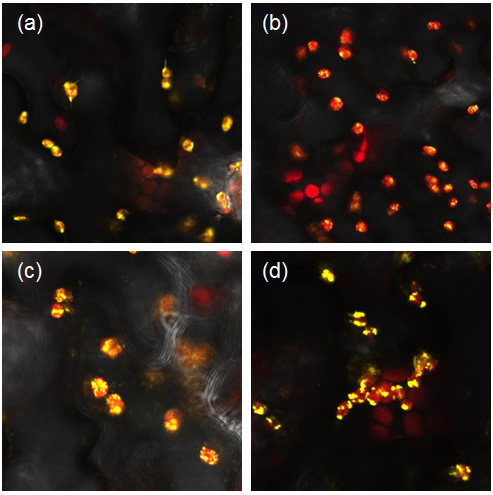Difference between revisions of "Part:BBa K1618028"
LedaCoelewij (Talk | contribs) |
Nicolapatron (Talk | contribs) |
||
| Line 2: | Line 2: | ||
<partinfo>BBa_K1618028 short</partinfo> | <partinfo>BBa_K1618028 short</partinfo> | ||
| − | + | BBa_K1618028 contains a synthetic plastid transit peptide from the consensus of multiple RuBisCo small subunit genes. In an N-terminal Fusion, this peptide provides subcellular localisation to the chloroplast. It is assembled in a Golden Gate Universal Acceptor Plasmid (pUAP1) in the pSB1C3 backbone according to RFC106. It is a Golden Gate part in the plant standard syntax, not a BioBrick. | |
| − | + | NRP-UEA 2015 team used this part in our plant constructs. Constructs K1618029-36 contained a 35s promoter, chloroplast transit peptide, one of four acyltransferases, and this new 35s terminator parts. In parts K1618029-32 fused the recombinant protein was fused to a fluorescent a reporter tag to confirm the localisation to the chloroplast (Figure 1). The parts were tested by transferring into <i>Agrobacterium tumefaciens</i> and infiltration into plants. The results confirm that the chloroplast transit peptide is functional and able to direct proteins to plant plastids. | |
| + | |||
<!-- --> | <!-- --> | ||
| Line 12: | Line 13: | ||
''Figure 1: Constructs BBa_K1618029-032 contain a yellow fluorescent protein, as well as a chloroplast transit peptide. These are confocal microscopy images of the constructs infiltrated into Nicotiana benthamiana, in which the red stains are the chloroplast, and the yellow fluorescence is construct (a) BBa_K1618029, (b) BBa_K1618031, (c) BBa_K1618032, and (d) BBa_K1618030'' | ''Figure 1: Constructs BBa_K1618029-032 contain a yellow fluorescent protein, as well as a chloroplast transit peptide. These are confocal microscopy images of the constructs infiltrated into Nicotiana benthamiana, in which the red stains are the chloroplast, and the yellow fluorescence is construct (a) BBa_K1618029, (b) BBa_K1618031, (c) BBa_K1618032, and (d) BBa_K1618030'' | ||
| − | + | ||
<!-- Add more about the biology of this part here | <!-- Add more about the biology of this part here | ||
Latest revision as of 16:27, 21 September 2015
Chloroplast Transit Peptide
BBa_K1618028 contains a synthetic plastid transit peptide from the consensus of multiple RuBisCo small subunit genes. In an N-terminal Fusion, this peptide provides subcellular localisation to the chloroplast. It is assembled in a Golden Gate Universal Acceptor Plasmid (pUAP1) in the pSB1C3 backbone according to RFC106. It is a Golden Gate part in the plant standard syntax, not a BioBrick.
NRP-UEA 2015 team used this part in our plant constructs. Constructs K1618029-36 contained a 35s promoter, chloroplast transit peptide, one of four acyltransferases, and this new 35s terminator parts. In parts K1618029-32 fused the recombinant protein was fused to a fluorescent a reporter tag to confirm the localisation to the chloroplast (Figure 1). The parts were tested by transferring into Agrobacterium tumefaciens and infiltration into plants. The results confirm that the chloroplast transit peptide is functional and able to direct proteins to plant plastids.
Figure 1: Constructs BBa_K1618029-032 contain a yellow fluorescent protein, as well as a chloroplast transit peptide. These are confocal microscopy images of the constructs infiltrated into Nicotiana benthamiana, in which the red stains are the chloroplast, and the yellow fluorescence is construct (a) BBa_K1618029, (b) BBa_K1618031, (c) BBa_K1618032, and (d) BBa_K1618030

